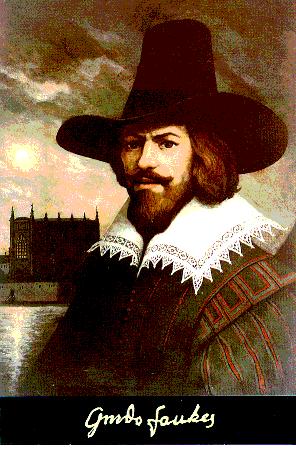The Life & Crimes of Guy Fawkes
| Author: AboutMyArea HeadOffice | Published: 3rd November 2009 20:22 |
Guy Fawkes, also known as Guido, was an Catholic Elizabethan nobleman, adventurer, and politician who became involved in the infamous Gunpowder Plot. The Plot was intended to overthrow the government and assassinate the Protestant monarch, James I, by blowing up the Houses of Parliament.
 However, the plot failed and, although he was a relatively minor player, Fawkes was to have lit the fuse and was the one caught in the act. He therefore achieved instant notoriety and became, by association, the principal villain and the main character in the public mind.
However, the plot failed and, although he was a relatively minor player, Fawkes was to have lit the fuse and was the one caught in the act. He therefore achieved instant notoriety and became, by association, the principal villain and the main character in the public mind.
...................
Background
1570 Born 13th April, Stonegate, York.
1570 Baptised, 16th April at Saint Michael-le-Belfrey, York
Parents : Edward and Edith Fawkes. His father was proctor of the ecclessiastical courts and advocate of the consistory court of the Archbishop of York
Family : two younger sisters, Elizabeth and Anne
1579 His father died and his mother Edith married again into a Catholic family
School : St. Peters School in York (he was a contemporary of John Wright and Christopher Wright who later became co-conspirators).
Little is known about his early life. His mother re-married and the family moved to Scotton. There is evidence, questioned by some chroniclers, that Fawkes married Anne Pullyn in 1592 and had a son, Thomas, the following year.
1591 Fawkes leased to Christopher Lomley of Yorke, tailor, "three and a half acres in Clifton, with one other acre there, and a barn and garth attached to Gilligaite" for twenty one years. This indicates that, on reaching the age of majority, he converted at least some of his inheritance into an income.
1593 Went to the Netherlands where he enlisted in the Spanish army under Archduke Albert of Austria. Fawkes held a post of command when the Spaniards took Calais in 1596 under the orders of King Philip II of Spain. Later he travelled to Spain in an attempt to persuade the king to send Catholic troops to invade England.
......................
The Gunpowder Plot
1603 When Elizabeth I died without children, James - the son of Mary, Queen of Scots - was next in line to the throne. As James was a Protestant, Parliament was also in favour of him becoming king. The Roman Catholics in England were upset that there was going to be another Protestant monarch. They also became very angry when James passed a law that imposed heavy fines on people who did not attend Protestant church services.
1604 In May, Robert Catesby devised the Gunpowder Plot, a scheme to kill James and as many Members of Parliament as possible. At a meeting at the Duck and Drake Inn Catesby explained his plan to Guy Fawkes, Thomas Percy, John Wright and Thomas Wintour. All the men agreed under oath to join the conspiracy. Over the next few months Francis Tresham, Everard Digby, Robert Wintour, Thomas Bates and Christopher Wright also agreed to take part in the overthrow of the king.
After the death of James in the explosion, Robert Catesby planned to make the king's young daughter, Elizabeth, queen. In time, Catesby hoped to arrange Elizabeth's marriage to a Catholic nobleman. It was Everard Digby's task to kidnap Princess Elizabeth from Coombe Abbey.
Catesby's plan involved blowing up the Houses of Parliament on 5th November. This date was chosen because the king was due to open Parliament on that day. At first the group tried to tunnel under Parliament. This plan changed when Thomas Percy was able to hire a cellar under the House of Lords. The plotters then filled the cellar with barrels of gunpowder. Fawkes, because of his munitions experience in the Netherlands, was given the task of creating the explosion.
The Plot was discovered when the cellars were searched the night before the opening. Fawkes was caught red-handed and although his fellow conspirators fled, they were cornered and either died resisting arrest or were captured and executed.
1606 Died 31st January Executed in the Garden of St. Paul's Cathedral / Old Palace Yard, Westminster
.......................
The Historical Consequences
King James I adapted an existing custom of celebrating the accession of a monarch with nationwide bonfires by passing a law making the festivities an annual event on November 5th. Although the law was repealed in 1859 the tradition remains. The character of Guy Fawkes is inseparable from November 5th which is today known variously as Guy Fawkes Day, Bonfire Night or Fireworks Night.
Report this article as inappropriate
Comments
You need to log in before you can do that! It's only a quick registration process to join the AMA network and completely free.



 Help
Help




 Loading...
Loading... Help
Help